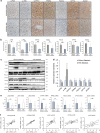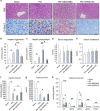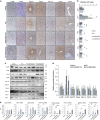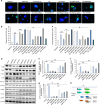p38α MAPK antagonizing JNK to control the hepatic fat accumulation in pediatric patients onset intestinal failure
- PMID: 29022907
- PMCID: PMC5682685
- DOI: 10.1038/cddis.2017.523
p38α MAPK antagonizing JNK to control the hepatic fat accumulation in pediatric patients onset intestinal failure
Abstract
The p38α mitogen-activated protein kinase (MAPK) has been related to gluconeogenesis and lipid metabolism. However, the roles and related mechanisms of p38α MAPK in intestinal failure (IF)-associated liver steatosis remained poor understood. Here, our experimental evidence suggested that p38α MAPK significantly suppressed the fat accumulation in livers of IF patients mainly through two mechanisms. On the one hand, p38α MAPK increased hepatic bile acid (BA) synthesis by upregulating the expression of the rate-limiting enzyme cholesterol 7-α-hydroxylase (CYP7A1) and peroxisome proliferator-activated receptor γ coactivator-1α (PGC-1α), which in turn activated the transcription of the CYP7A1. On the other hand, p38α MAPK promoted fatty acid (FA) β-oxidation via upregulating peroxisome proliferator-activated receptor alpha (PPARα) and its transcriptional target genes carnitine palmitoyltransferase 1A (CPT1A) and peroxisomal acyl-coenzyme aoxidase 1 (ACOX1). Dual luciferase assays indicated that p38α MAPK increased the transcription of PPARα, PGC-1α and CYP7A1 by upregulating their promoters' activities. In addition, in vitro and in vivo assays indicated p38α MAPK negatively regulates the hepatic steatosis by controlling JNK activation. In conculsion, our findings demonstrate that hepatic p38α MAPK functions as a negative regulator of liver steatosis in maintaining BA synthesis and FAO by antagonizing the c-Jun N-terminal kinase (JNK).
Conflict of interest statement
The authors declare no conflict of interest.
Figures





Similar articles
-
Peroxisome proliferator activated receptor alpha (PPARalpha) and PPAR gamma coactivator (PGC-1alpha) induce carnitine palmitoyltransferase IA (CPT-1A) via independent gene elements.Mol Cell Endocrinol. 2010 Aug 30;325(1-2):54-63. doi: 10.1016/j.mce.2010.05.019. Mol Cell Endocrinol. 2010. PMID: 20638986 Free PMC article.
-
Peroxisome proliferator-activated receptor-gamma coactivator-1alpha activation of CYP7A1 during food restriction and diabetes is still inhibited by small heterodimer partner.J Biol Chem. 2008 May 30;283(22):15089-96. doi: 10.1074/jbc.M710452200. Epub 2008 Apr 2. J Biol Chem. 2008. PMID: 18385139 Free PMC article.
-
LB100 ameliorates nonalcoholic fatty liver disease via the AMPK/Sirt1 pathway.World J Gastroenterol. 2019 Dec 7;25(45):6607-6618. doi: 10.3748/wjg.v25.i45.6607. World J Gastroenterol. 2019. PMID: 31832001 Free PMC article.
-
Free radical biology for medicine: learning from nonalcoholic fatty liver disease.Free Radic Biol Med. 2013 Dec;65:952-968. doi: 10.1016/j.freeradbiomed.2013.08.174. Epub 2013 Aug 29. Free Radic Biol Med. 2013. PMID: 23994574 Review.
-
Regulation of energy metabolism by long-chain fatty acids.Prog Lipid Res. 2014 Jan;53:124-44. doi: 10.1016/j.plipres.2013.12.001. Epub 2013 Dec 18. Prog Lipid Res. 2014. PMID: 24362249 Review.
Cited by
-
AKR1C3-dependent lipid droplet formation confers hepatocellular carcinoma cell adaptability to targeted therapy.Theranostics. 2022 Nov 7;12(18):7681-7698. doi: 10.7150/thno.74974. eCollection 2022. Theranostics. 2022. PMID: 36451864 Free PMC article.
-
Update on the Benefits and Mechanisms of Action of the Bioactive Vegetal Alkaloid Berberine on Lipid Metabolism and Homeostasis.Cholesterol. 2018 Jul 2;2018:7173920. doi: 10.1155/2018/7173920. eCollection 2018. Cholesterol. 2018. PMID: 30057809 Free PMC article. Review.
-
Recent Advances Regarding the Molecular Mechanisms of Triterpenic Acids: A Review (Part II).Int J Mol Sci. 2022 Aug 10;23(16):8896. doi: 10.3390/ijms23168896. Int J Mol Sci. 2022. PMID: 36012159 Free PMC article. Review.
-
Fibrates as drugs with senolytic and autophagic activity for osteoarthritis therapy.EBioMedicine. 2019 Jul;45:588-605. doi: 10.1016/j.ebiom.2019.06.049. Epub 2019 Jul 5. EBioMedicine. 2019. PMID: 31285188 Free PMC article.
-
Molecular mechanisms involved in drug-induced liver injury caused by urate-lowering Chinese herbs: A network pharmacology study and biology experiments.PLoS One. 2019 May 29;14(5):e0216948. doi: 10.1371/journal.pone.0216948. eCollection 2019. PLoS One. 2019. PMID: 31141540 Free PMC article.
References
-
- Wiles A, Woodward JM. Recent advances in the management of intestinal failure-associated liver disease. Curr Opin Clin Nutr Metab Care 2009; 12: 265–272. - PubMed
-
- Carter BA, Karpen SJ. Intestinal failure-associated liver disease: management and treatment strategies past, present, and future. Semin Liver Dis 2007; 27: 251–258. - PubMed
-
- Lauriti G, Zani A, Aufieri R, Cananzi M, Chiesa PL, Eaton S et al. Incidence, prevention, and treatment of parenteral nutrition-associated cholestasis and intestinal failure-associated liver disease in infants and children: a systematic review. JPEN 2014; 38: 70–85. - PubMed
-
- Kurvinen A, Nissinen MJ, Andersson S, Korhonen P, Ruuska T, Taimisto M et al. Parenteral plant sterols and intestinal failure-associated liver disease in neonates. J Pediatr Gastroenterol Nutr 2012; 54: 803–811. - PubMed
-
- Nehra D, Fallon EM, Puder M. The prevention and treatment of intestinal failure-associated liver disease in neonates and children. Surg Clin N Am 2011; 91: 543–563. - PubMed
MeSH terms
Substances
LinkOut - more resources
Full Text Sources
Other Literature Sources
Molecular Biology Databases
Research Materials
Miscellaneous

